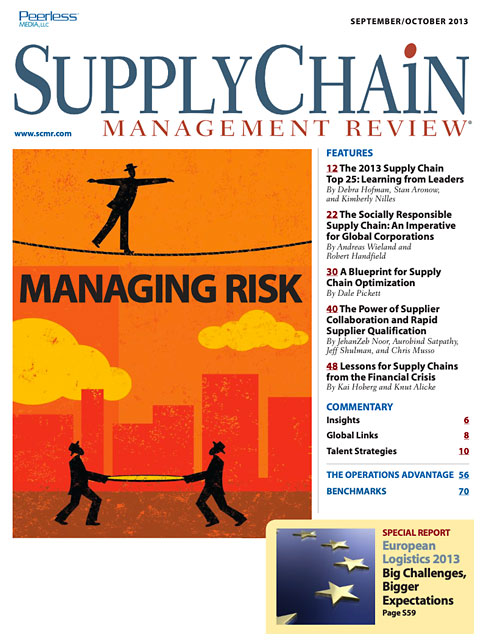Sorry, but your login has failed. Please recheck your login information and resubmit. If your subscription has expired, renew here.
September-October 2013
The 2013 ranking of supply chain leaders from Gartner highlights the best of the best—large, global companies that are furthest along on the journey toward demand-driven supply chains. While the mix of companies is diverse, there are lessons to be learned from these supply chain leaders. Browse this issue archive.Need Help? Contact customer service 847-559-7581 More options
It is indeed an ill wind that blows nobody any good. Fruit company Chiquita found that out to its benefit in 1998, when Hurricane Mitch ripped through Honduras, where much of the well-known banana brand’s produce came from. The company actually increased its revenue by 4 percent while its competitor’s revenue dropped by exactly that amount.
The hurricane destroyed about $900 million worth of crops—including four-fifths of the nation’s banana crop. More than 70 percent of Honduras’ transportation infrastructure was washed away. Chiquita’s fruit was affected of course, but its rival, Dole, was hurt much worse; Dole lost 70 percent of its banana supply. What was Chiquita’s smart move? It was much more nimble, qualifying and signing up alternative suppliers in areas unaffected by the storm and activating deliveries from them. By being far more responsive than Dole, Chiquita was able to outperform its more powerful competitor.
Chiquita’s fundamental master stroke was to approach relations with its suppliers in a collaborative way. On top of that, it had built supplier qualification processes that enabled it to bring the new suppliers online in very short order.
 |
This complete article is available to subscribers
only. Click on Log In Now at the top of this article for full access. Or, Start your PLUS+ subscription for instant access. |
Not ready to subscribe, but need this article?
Buy the complete article now. Only $20.00. Instant PDF Download.
Access the complete issue of Supply Chain Management Review magazine featuring
this article including every word, chart and table exactly as it appeared in the magazine.
SC
MR
Sorry, but your login has failed. Please recheck your login information and resubmit. If your subscription has expired, renew here.
September-October 2013
The 2013 ranking of supply chain leaders from Gartner highlights the best of the best—large, global companies that are furthest along on the journey toward demand-driven supply chains. While the mix of companies is… Browse this issue archive. Access your online digital edition. Download a PDF file of the September-October 2013 issue.
 |
Download Article PDF |
It is indeed an ill wind that blows nobody any good. Fruit company Chiquita found that out to its benefit in 1998, when Hurricane Mitch ripped through Honduras, where much of the well-known banana brand’s produce came from. The company actually increased its revenue by 4 percent while its competitor’s revenue dropped by exactly that amount.
The hurricane destroyed about $900 million worth of crops—including four-fifths of the nation’s banana crop. More than 70 percent of Honduras’ transportation infrastructure was washed away. Chiquita’s fruit was affected of course, but its rival, Dole, was hurt much worse; Dole lost 70 percent of its banana supply. What was Chiquita’s smart move? It was much more nimble, qualifying and signing up alternative suppliers in areas unaffected by the storm and activating deliveries from them. By being far more responsive than Dole, Chiquita was able to outperform its more powerful competitor.
Chiquita’s fundamental master stroke was to approach relations with its suppliers in a collaborative way. On top of that, it had built supplier qualification processes that enabled it to bring the new suppliers online in very short order.
 |
SUBSCRIBERS: Click here to download PDF of the full article. |
SC
MR

Latest Supply Chain News
- Tech investments bring revenue increases, survey finds
- Survey reveals strategies for addressing supply chain, logistics labor shortages
- Israel, Ukraine aid package to increase pressure on aerospace and defense supply chains
- How CPG brands can deliver on supplier diversity promises
- How S&OP provides the answer to in-demand products
- More News
Latest Resources

 Explore
Explore
Latest Supply Chain News
- Tech investments bring revenue increases, survey finds
- Survey reveals strategies for addressing supply chain, logistics labor shortages
- Israel, Ukraine aid package to increase pressure on aerospace and defense supply chains
- How CPG brands can deliver on supplier diversity promises
- How S&OP provides the answer to in-demand products
- AI, virtual reality is bringing experiential learning into the modern age
- More latest news
Latest Resources

Subscribe

Supply Chain Management Review delivers the best industry content.

Editors’ Picks





